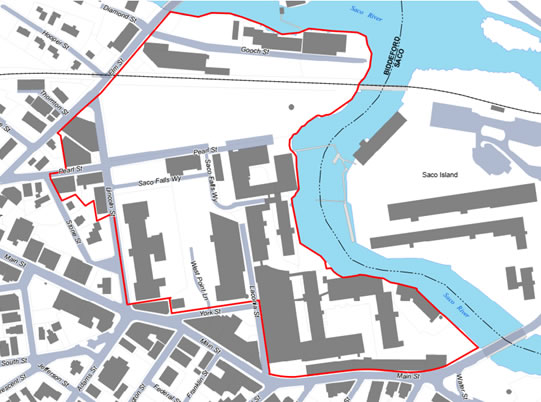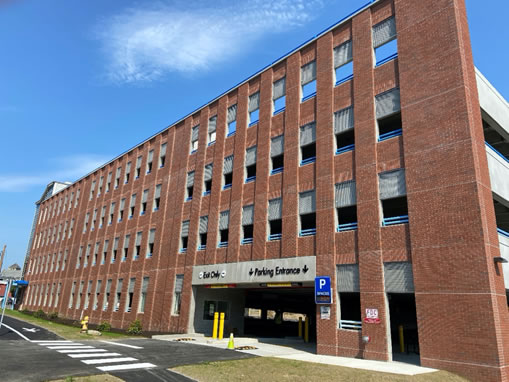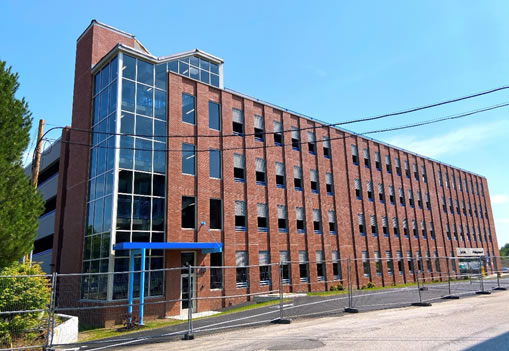The City of Biddeford, Maine, used an innovative form of joint development called a progressive development agreement to design, fund, construct, and operate a downtown parking structure and related pedestrian amenities that had long been recognized as important for the city’s downtown vitality and economic development. As in many downtowns in small and midsized cities across the country, projections indicated that parking revenues would be insufficient to cover the full cost of the facility, so an allocation from an existing TIF district was used to close the gap. As an added measure of risk mitigation, the city formed a special assessment district encompassing downtown commercial properties that levies an assessment only if parking revenues fall below 90 percent of projections. This funding plan allowed the city to keep its promise to complete the project without residential property taxes.
Project name |
Pearl Street Garage and Riverwalk |
|---|---|
Location |
Biddeford, ME |
Built environment |
Urban |
Economically distressed or opportunity zone? |
No |
Type of infrastructure |
640-space parking garage and part of the city’s Riverwalk and pedestrian connections |
Total infrastructure cost |
$22.3–24.6 million |
Value capture techniques |
|
Summary of funding plan |
Biddeford RiverWalk Community 1, LLC provided the up-front financing to build and operate a parking garage on a city-owned parcel under a progressive development agreement with a 25-year concession. |
Amount of value capture |
|
Duration of value capture |
25-year contract, with the city having the option to exit the agreement after 10 years |
Value capture innovation |
|
Notable outcomes |
The city was able to meet its commitment to building the facility without residential property taxes. |
Biddeford, located 15 miles south of Portland and 90 miles north of Boston, is the sixth-largest city in Maine and a major employment and commercial center in York County. In the late 1800s and early 1900s, Biddeford was a vibrant industrial city with a compact, bustling downtown where the majority of mill workers walked to work. The decline of the textile industry, however, left the downtown with 35 vacant textile mill buildings encompassing more than two million square feet of former industrial space.1
In the mid-1980s, the Maine Energy Recovery Co. (MERC) established a trash incinerator at 3 Lincoln Street, bringing the odor of burning trash and a regular stream of trash trucks to the downtown area. Stigmatized by the incinerator, the downtown languished with an estimated one ;million square feet of vacant space, with a small amount of mixed-use activity, including office, first floor retail, and residential units. High vacancy was exacerbated by development patterns that obscured what activity there was and disadvantageous urban design. Some downtown commercial buildings were occupied by operating businesses but appeared vacant, and approaches to the downtown Mill District were described as “uninviting and give little insight into the beauty of the district.”2
This parking garage is a critical piece in the redevelopment and reemergence of Biddeford as a desirable community. … It shatters the old stereotype of the city being nothing more than a dying mill town, and it provides the needed parking spaces to be a catalyst for future development within the downtown. I believe that it is symbolic in who we are as a people and who we want to be.
—Mayor Alan Casavant at the groundbreaking ceremony,
August 11, 2020
In 2005, the city attempted to buy and close the incinerator, a referendum vote failed due to its $30 million price. By 2012, real estate prices had come down and MERC was no longer interested in operating the facility, and the city was able to purchase the 8.5-acre riverfront parcel for $6.65 million.
With the incinerator gone, downtown Biddeford was poised for revitalization. The 2009 Mill District Master Plan recommended leveraging downtown’s natural walkability and proximity to the riverfront to create the “RiverWalk.” RiverWalk would be the star attraction of a downtown open-space network that would reveal dramatic waterfalls previously obscured from view and connect with other downtown parks, a proposed rail trail, and a pedestrian bridge over the river to sister city Saco, Maine. The master plan also estimated that at full build-out, the revitalized Mill District would require 2,500 to 3,000 parking spaces, well above the 676 surface parking spots available at the time. Furthermore, the preponderance of surface parking lots undermined the vibrant “urban experience” that champions of downtown Biddeford wished to create.
After a decade of analysis, planning, and debate, the city designed a project to construct a 640-space parking garage on the city-owned former incinerator property at 3 Lincoln Street, with pedestrian connections to the RiverWalk. Furthermore, the mayor pledged to complete the more than $20 million project without using residential property tax and without increasing property tax rates.
In Maine, municipalities do not receive a share of sales taxes, so property taxes are the only source of tax revenue available to fund municipal projects. Borrowing requires voter approval, which limits the city’s ability to finance municipal projects. Voters had already approved the borrowing necessary for the incinerator purchase, which was being repaid in part through a special tax district, and voters had little appetite for additional borrowing.
The MERC facility had been the largest property taxpayer in Biddeford, paying about $850,000 per year. This revenue source was lost when the facility transferred to city ownership, resulting in an increase in the city’s property tax rate.
In all but the most densely developed urban areas, parking fees are typically too low to cover the cost of constructing the facility. In 2014, the city proposed installing parking meters for on-street parking to generate revenue to apply to the cost of a parking garage, but opponents responded with a citizen’s referendum banning the use of parking meters downtown, which won by popular vote. This eliminated parking meters as a potential revenue source and preserved free on-street parking in Downtown Biddeford to compete with any proposed paid parking.
Ultimately, a funding plan was assembled from three components:
In 2019, the city signed the Biddeford Urban Core Transportation Joint Development Agreement with Biddeford RiverWalk Community 1, LLC.3 The agreement took the form of a progressive development agreement, a type of development agreement also called progressive design-build agreement or pre-development agreement. Under a progressive development agreement (PDA), a private investor (i.e., a developer) is deeply involved in project design and pre-development. Through that involvement, the developer obtains the information necessary to provide a guaranteed maximum price to complete the project. In exchange, the municipality extends a right of first refusal to the investor to bid on project construction. Such agreements are intended to improve project design, reduce project cost, speed project completion, and reduce risk.
Biddeford RiverWalk Community 1 (designated as the developer in the PDA) is a limited-liability company (LLC) that invested in the Pearl Street Garage and Riverwalk project. Each of three firms in the LLC brought its particular expertise to the project (see Table 1). To complete the project, a construction company, a consulting firm specializing in parking design and management, and two commercial lenders joined the LLC under the umbrella entity Biddeford Innovation Group.
The private investors worked with city staff to analyze future development of Downtown Biddeford resulting from development of the remainder of the 3 Lincoln Street parcel, completion of the RiverWalk, and future Mill District revitalization, and used that analysis to project demand for additional parking and make revenue projections. The city had already worked with Treadwell Franklin Infrastructure Capital to complete the facility’s design, and under the PDA, the investors agreed to accept this design. In its advisory role, the investor team analyzed the project’s fiscal and traffic impacts on the Mill District Master Plan for the city.
With progressive design-build agreements, the design-build contractor is selected primarily on qualifications (rather than cost) and is brought on as part of the owner's team at a very early stage of project design. In contrast to project development through Construction Manager at Risk (CMAR) and Construction Manager/General Contractor (CM/GC) procurement approaches, the design firm and contractor are selected and contracted under a single procurement. The design-build contractor will either assist the owner in developing the design or advance the design from what the owner has already developed. At approximately 60 percent design, the design-build contractor submits a commercial proposal to complete design and construction for a fixed price and schedule with performance guarantees. Owners can use third parties to verify cost and can complete a competitive procurement if the parties cannot agree to the design-build contractor's proposed cost.
(Source: “Early Involvement of Private Developers in the Consideration of Long-Term Public-Private Partnership Concession Options: A Discussion Paper”, February 2017, U.S. Department of Transportation, https://www.fhwa.dot.gov/ipd/pdfs/p3/early_involvement_private_sector_p3s.pdf)
| Partner Firm | Firm Expertise |
Project Role |
|---|---|---|
Treadwell Franklin Infrastructure Capital |
A Maine-based developer, owner, and servicer of municipal and institutional infrastructure in New England and several mid-Atlantic states, and parent company to Sewall, the infrastructure engineering and construction firm also on the team |
Lead project developer |
Sewall |
A 140-year-old Maine engineering company with GIS, survey, civil engineering, and traffic planning expertise |
Construction and program management |
Desman Design Management |
A national firm that specializes in parking consulting, design, planning and restoration. |
Market study and feasibility analysis |
Amber Infrastructure Group |
An international infrastructure specialist focused on investment origination, development, and asset management of public, transport, energy, digital, and demographic infrastructure. The firm uses a long-term, buy-and-hold strategy for $10 billion in assets. |
Equity sponsor |
Gorham Savings Bank and KeyBank |
Commercial bank |
Project debt provider and lender |
The private partners then developed a cost estimate of $22.3 million with a not-to-exceed price of $24.6 million, which the city accepted under a 25-year agreement. The private partners retained a construction firm and secured project financing to complete construction (assuming the cost up front).
Biddeford RiverWalk Community 1, LLC was granted a 25-year lease to operate the Pearl Street Parking Garage and to operate and manage seven city-owned surface parking lots downtown (including paid spaces and those the city committed to preserving as free parking). The LLC hired a parking operator to perform operations and management duties.
The PDA established parking rates for the 25-year contract period, which increase over time. The agreement also enables the city to “buy down” rate increases if city officials find that rates are too high, and to raise prices as necessary to meet demand.
In year 10 of the contract, the city has the option to (1) continue with the agreement through Year 25, (2) end the agreement and purchase the garage from the investor, or (3) end the agreement and sell the garage. If the city continues through Year 25, it then assumes ownership of the structure for $1.
Parking revenue projections for fiscal 2021 to fiscal 2030 are for annual revenues to begin at about $575,000 and increase to just under $1.2 million by the end of the 10-year period. The projections also indicated a need for additional support ranging from $650,000 in the first fiscal year to nearly $1 million in year 10.4 The city opted to close this remaining funding gap by dedicating funds from an existing TIF district dedicated to downtown revitalization.
The Route 111-Mill Redevelopment Tax Increment Financing District was established in 2004 as the Alfred-Andrews Development and Tax Increment Financing District. The TIF district was created in response to new big box-style commercial-retail development occurring along portions of Route 111 outside the downtown area. Captured revenue was intended to fund public facilities and improvements needed for that development as well as city economic development projects and activities in the downtown to prevent the new retail offerings from diverting economic activity from downtown revitalization efforts.
Under the original development program, the TIF period was 12 years. The original boundaries contained 25 parcels, including parcels along Route 111 as well as downtown, encompassing approximately 229 acres in total. The initial original assessed value (tax increment base) of the district was $4,986,100 (in 2004 dollars). The TIF development program has been amended 10 times, extending the TIF period to 14 then 25 years, adding downtown parcels targeted for re-development, removing parcels to be included in new downtown TIF districts, removing program elements no longer planned, and adding new program elements. The amendments include adjustment to the baseline value, as necessitated by changes to property additions and removals (and in a few cases, to correct minor errors in the valuations of a few properties that were discovered during the adjustment process).
The TIF agreement allocates $15 million to what it terms a “subdistrict,” the Mill Central Parking Facility, and an additional $2 million to another subdistrict, the Mill Riverwalk and pedestrian connector to Saco Island. But through the first 10 years of the agreement, the contract with Biddeford RiverWalk Community 1 allocates only $8,376,659 from the Mill District tax increment; further TIF allocations are at the discretion of the city.
The City created a special assessment district (SAD) made up of downtown commercial properties near the parking structure (Figure 1), but the special assessment will be levied only if the City is required to make stabilization payments to the developer under the terms of the joint development agreement. This occurs if the developer’s net operating income, evaluated on a semiannual basis, falls below 90 percent of projections because of deviations in operation and maintenance costs and expenses and/or parking system revenues.5
Figure 1 . Special Assessment District Map

Source: City of Biddeford, Maine GIS
TIF and SAD are complementary techniques. Revenues from SADs are relatively predictable because they are not contingent on increasing property values. SADs do require, however, that property owners agree to pay an additional tax. Under a TIF, the rate paid by property owners remains the same, but revenues are more speculative because they depend on increasing property values. The two techniques can be used together, with the SAD backstopping the TIF. In the Pearl River case, the TIF funds had already been collected and were not a source of funding risk. Instead, the (conditional) SAD was used to mitigate the parking revenue risk borne by the private developer.
Though many in the community were supportive of the project, there was opposition. Some opposed the project out of general opposition to government action and preference for limited government. Others were opposed to any paid downtown parking, including many who supported the ban on downtown parking meters and who saw the garage as undermining the spirit of that ban. And some opposed the project in broad opposition to the mayor and/or city councilmembers.
In Biddeford, the mayor and entire City Council is up for election every two years, and the city was in negotiations with the private investor during an election season. A slate of candidates ran on a platform opposing the parking structure project, but none was elected. The mayor and city councilmembers supporting the project dedicated significant political capital to communicating the need for and benefits of the project.
In 2019, before the garage project had broken ground, the facility had already enabled downtown development. The structure, which officially opens in July 2021, occupies only a portion of the city-owned riverfront property that formerly housed the MERC incinerator. Motivated in part by the new parking facility, two Portland-based developer-investors joined under the name B.E. Fitler to invest $90 million in redeveloping the remaining portions of the city-owned parcel—which are on either side of the new garage—to create the Pearl Street Riverfront District.6 B.E. Fitler and the city entered into a master plan development agreement stipulating that “the design of the new structures will require access to and be dependent on the proposed Parking Garage,” and establishing an option for the developer to purchase the parcels.7
Figure 2. Pearl Street Parking Garage, 2021 (Completed)


Photo Credit: City of Biddeford
The following developments supported by the new parking garage have also been planned or completed:
Thanks to James Bennett, City Manager, City of Biddeford, Maine, for their time and cooperation.
1 2009 Mill District Master Plan
2 2009 Mill District Master Plan
3 The draft of the agreement reviewed by the Biddeford City Council in November 2019 is available at https://legistarweb-production.s3.amazonaws.com/uploads/attachment/pdf/469916/11-12-2019_Parking_Garage_Joint_Development_Agreement_-_City_Council_Workshop.pdf
4 https://www.biddefordmaine.org/DocumentCenter/View/5233/Garage-Finance-Summary-Table
5 City Council Meeting November 19, 2019, Orders of the Day – 8j, 2019.130) Authorization/Proceed with Development of a Process for the Establishment of a Special Assessment District https://legistarweb-production.s3.amazonaws.com/uploads/attachment/pdf/475375/20191119_City_Council_Briefing_Memo_Item_8.j_-_Special_Assessment_District.pdf
6 https://www.pressherald.com/2021/04/12/federal-grant-to-help-biddeford-fix-pearl-street-another-step-in-riverfront-revitalization-officials-say/
7 Master Plan Development Agreement between BE Fitler LLC and City of Biddeford, ME, https://legistarweb-production.s3.amazonaws.com/uploads/attachment/pdf/334051/BE_Fitler_Master_Plan_Development_Agreement.pdf
8 In Biddeford, Phase 1 Riverdam Mill almost fully preleased in just a month,” Laurie Schreiber, July 27, 2020, Mainebiz.com, https://www.mainebiz.biz/article/in-biddeford-phase-1-riverdam-mill-almost-fully-preleased-in-just-a-month
9 “Nearly 100 apartments planned for Biddeford industrial building,” Laurie Schreiber, Mainebiz.com, March 22, 2021, https://www.mainebiz.biz/article/nearly-100-apartments-planned-for-biddeford-industrial-building